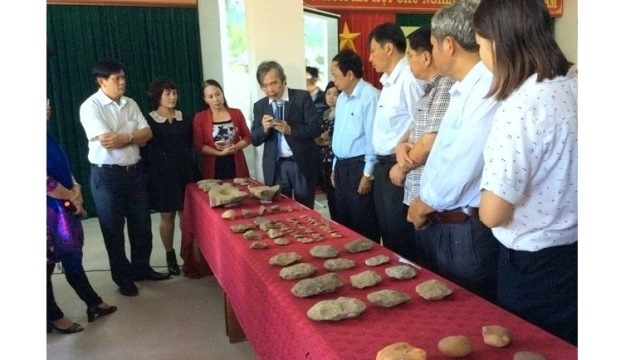
An ancient workshop producing stone tools dating back over 5,000 years ago have been found by archaeologists in Ia Boong commune, Chu Prong district, in the Central Highlands province of Gia Lai.
An ancient workshop producing stone tools dating back over 5,000 years ago have been found by archaeologists in Ia Boong commune, Chu Prong district, in the Central Highlands province of Gia Lai.
The discovery was announced at a recent workshop hosted by the province’s Department of Culture, Sports and Tourism, the Gia Lai Museum and the Vietnam Institute of Archaeology (VIA) to provide preliminary report of the excavation at the Ga 7 village in the Ia Boong commune.
 |
| Ancient stone artifacts discovered at Ga 7 village introduced to the public. (Credit: NDO) |
Accordingly, the site at Ga 7 was discovered by the staff from the VIA and Gia Lai Museum in April 2015 when they were conducting a pre-historic archeological investigation along the Ia Mor stream in Chu Prong district with 15 pre-historic sites.
In 2016, after investigating around the village, archaeologists found that Ga 7 was similar to the previous vestiges, but the stratum was well preserved. On that basis, Gia Lai Department of Culture, Sports and Tourism coordinated with the VIA to excavate relics at Ga 7 village.
According to the preliminary report by Assoc. Prof., Dr. Nguyen Khac Su from the VIA, through excavation, researchers discovered 234 objects divided into two groups: production tool group with 205 artifacts (87.6%) including axes, disc-shaped tools, oval tools, chocks and objects for sitting; the group of scrap and materials including strips and stone materials with 29 objects (accounting for 12.4%).
Based on the characteristics of the artifacts and excavation sites, researchers concluded that the village is considered a permanent residence and stone workshop dating from 5,000-5,500 years ago.
The excavation of Ga 7 village adds a new type of stone axe workshop (oval axes) for the Gia Lai prehistory, along with workshops which have already been found, making stone oval axes bearing the imprint of the late Hoabinhian technology, such as Thon Tam (Dak Nong province), Buon Kieu (Dak Lak province), Eo Bong (Phu Yen province), Gia Canh (Dong Nai province) and Bau Du (Quang Nam province), Ga 7 creates a unified appearance for the whole Central Highlands and the delta area in the central region, thereby helping to add materials to compile history after the Hoa Binh culture (12,000-10,000 BC) in the southern land of the ancient culture.
To protect the integrity of this area, the VIA recommended professional agencies to erect protection signs at the site, while building records for its recognition as a provincial relic and continuing excavation to further clarify whether the relationship of three types of axe making at the site is ethnically related or environmentally compatible.
(Source:Nhan Dan)





